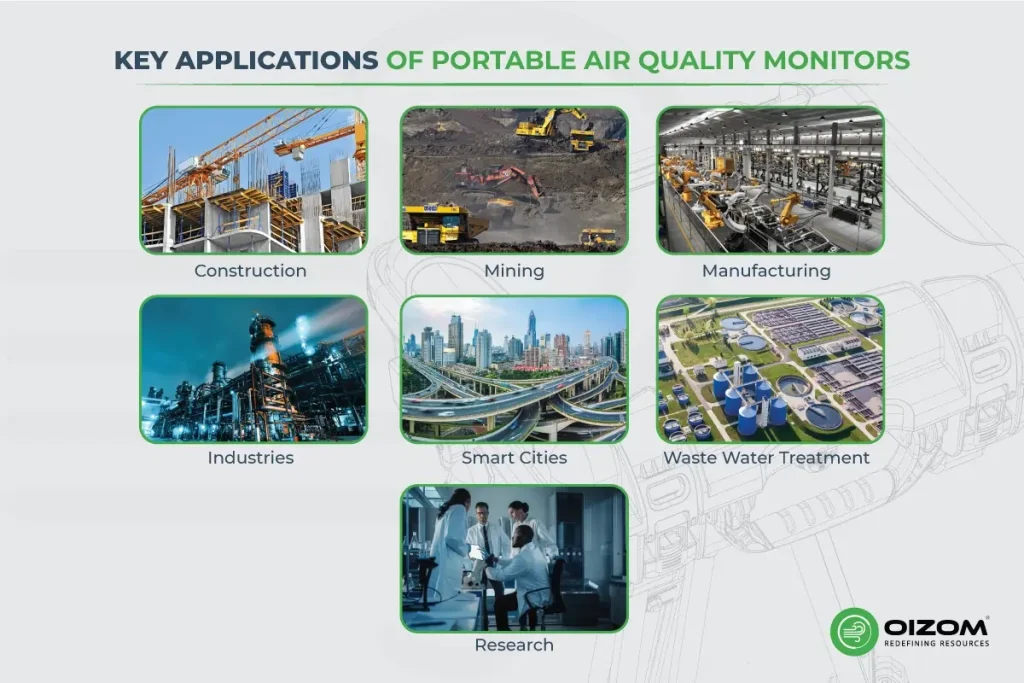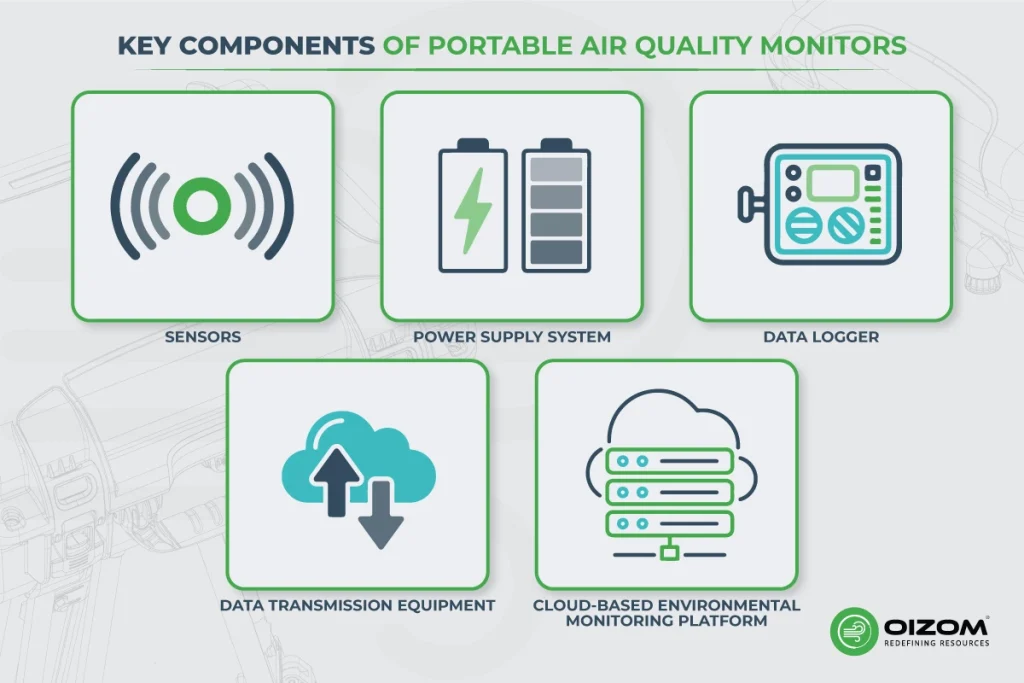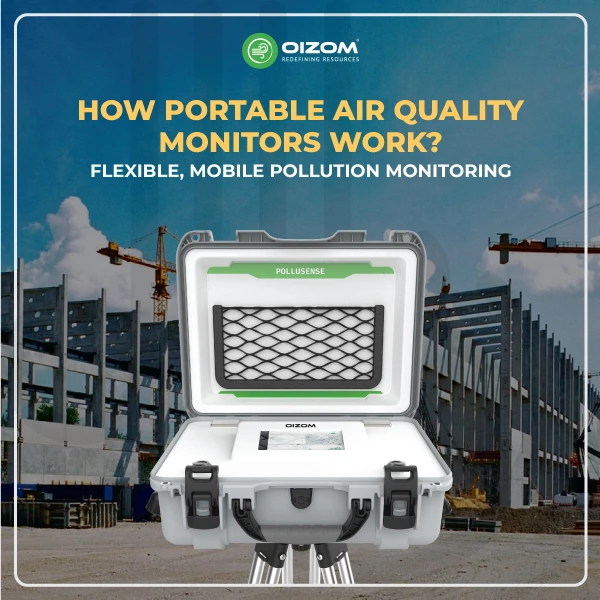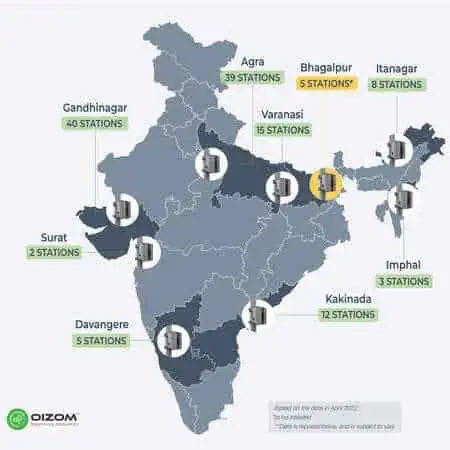10 key takeaway points:
- Air Pollution Threat: Air pollution is the No. 1 health risk, contributing to millions of deaths annually. Accurate measurement is essential for effective management.
- Portable Monitors: Portable air quality monitors provide real-time data and are flexible, allowing for more comprehensive assessments compared to fixed stations.
- Key Applications: These monitors are valuable in industries like manufacturing, mining, and construction, as well as in environmental research, urban planning, and public health.
- Advanced Sensor Technology: Portable monitors use sensors like laser-based and electrochemical, PID, and NDIR sensors to measure particulate matter and gases, ensuring accurate real-time data.
- Pollusense: Oizom’s Pollusense is a portable air quality monitor equipped with advanced sensors designed to deliver accurate data in real-time across diverse environments.
- Data Processing: Portable monitors like Pollusense provide seamless data transmission to cloud platforms for real-time analysis and actionable insights.
- Calibration: Regular calibration is crucial to ensure the accuracy of portable air quality monitors, especially in extreme conditions.
- Power Source: Portable monitors are equipped with rechargeable batteries or solar panels to ensure uninterrupted monitoring in remote areas.
- Limitations: Portable monitors may have limited pollutant detection range and data storage but offer flexibility for targeted monitoring.
- Conclusion: Portable air quality monitors, like Pollusense, are revolutionizing air quality management by making data accessible, protecting public health, and improving environmental quality.
How Portable Air Quality Monitors Work? Flexible, Mobile Pollution Monitoring.
Air pollution is now widely recognized as a serious threat to both health and the environment. Did you know that it’s the No. 1 health risk, contributing to around 1.9 million heart disease deaths and nearly a million strokes annually? Despite this, effective air quality management starts with one key step: measuring it accurately.
There are several ways to measure air quality, from traditional reference-grade monitors to innovative mobile air quality sensors, low-cost stationary sensors, and even satellite technology. Interestingly, other alternative forms of some projects have even used moss to detect pollution sources!
As air quality concerns grow, more dynamic and flexible monitoring methods are becoming essential. Portable air quality monitors are revolutionizing the way we measure pollution, offering a more detailed and real-time view of air quality compared to fixed monitoring stations. In this blog, we’ll take a closer look at portable air quality monitoring, exploring its key applications, the sensor technology behind it, the essential components, and the limitations to keep in mind.
Overview of portable air quality monitor
Recent developments in air quality monitoring technologies present exciting possibilities for the future of air quality management. Traditionally, air quality has been monitored using fixed instruments placed in the same locations, collecting continuous data. While this method works, it requires multiple sites to get a complete picture of how air quality changes across an area. However, it has its limitations. In busy cities with heavy traffic, urban canyons, shifting weather, and sporadic emissions, air quality can vary a lot, and fixed networks may miss these changes.
In some cases, like quickly assessing a diesel emissions issue or checking the impact of a new policy, fixed stations may not provide the flexibility needed. Sometimes, existing networks have gaps or simply aren’t enough to give a full understanding. Also, there may be situations where a permanent monitoring station isn’t necessary or affordable. This is where portable monitoring comes in, offering a more detailed and adaptable view of air quality.
Portable air quality monitoring techniques enable us to intensively characterize air quality rather than depending on permanent locations to provide a representative picture. Portable monitoring provides more opportunities to test air quality in a given area by employing portable sites that may be moved to multiple locations. This mobility also makes it easier to identify specific pollutants commonly detected by portable air monitors, offering deeper insights into localized air quality issues.
Key Applications of Portable Air Quality Monitors

Portable air quality monitors are becoming essential tools in various applications due to their flexibility and ease of use. One key application is in industrial settings, where they help monitor emissions and ensure compliance with environmental regulations. Industries like:
- manufacturing,
- mining,
- construction uses these devices to keep tabs on pollutants and ensure a safe working environment.
Another important application is in environmental research and urban planning. Portable monitors allow researchers and city planners to collect real-time data across different locations, helping to identify pollution hotspots and guide better urban design or policy decisions.
In public health, portable air quality monitor placement are used to track pollution levels in real-time, providing critical data to healthcare professionals and policymakers to address air quality-related health risks, especially in areas prone to high pollution levels. Overall, these versatile devices are helping industries, researchers, EHS officers, and the construction industry to take control of air quality monitoring, providing real-time insights that traditional fixed monitors might miss.
Understanding the Mechanism of Portable Air Quality Monitors
Portable air quality monitors work by detecting and measuring pollutants in the air around them. They’re equipped with various sensors that track specific pollutants like particulate matter (PM), gases (such as CO2, NO2, ozone, and other relevant gases), and even environmental factors like temperature and humidity. These sensors gather data in real-time, providing a clear snapshot of the air quality at any given moment.
The device typically uses laser-based or electrochemical sensors to capture the concentration of different pollutants. For example, laser sensors are commonly used to detect particulate matter by measuring how light scatters when it hits particles in the air. Electrochemical sensors, on the other hand, measure gases by reacting chemically with the pollutants to produce an electrical signal.
What makes portable monitors stand out is their ability to collect data on the go. Unlike fixed monitors, they can be used anywhere from industrial sites to neighborhoods, providing more flexible and immediate air quality assessments. Many portable monitors also feature wireless connectivity, allowing real-time data transmission to smartphones or cloud-based platforms for easy analysis.
Sensor Technology in Portable Air Quality Monitors
Portable air quality monitors rely on advanced sensor technology to detect pollutants and environmental conditions in real-time. The most common types of sensors include laser-based, non-dispersive infrared rays, photoionization detectors, and electrochemical sensors, each designed to measure specific elements in the air.
Laser sensors are often used to detect particulate matter (PM), such as PM2.5 or PM10. These sensors work by emitting a laser beam and measuring how it scatters when it hits airborne particles. The amount of scattering helps determine the size and concentration of the particles in the air.
Electrochemical sensors, on the other hand, are used to measure gases like nitrogen dioxide (NO2), carbon monoxide (CO), or ozone (O3). These sensors create a chemical reaction when they come into contact with specific gases, generating an electrical signal that reflects the concentration of the pollutant. Some portable monitors also include sensors for temperature, humidity, and pressure, providing a fuller picture of environmental conditions that can impact air quality.
Did you know Oizom has just launched its latest innovation, Pollusense? It’s a portable air quality monitor designed to provide accurate, real-time data on pollutants and environmental conditions. Equipped with advanced sensor technology, Pollusense uses laser-based, PID, MPS, and electrochemical sensors to detect particulate matter, gases like NO2, CH4, and VOCs, and even environmental factors like temperature, humidity, and pressure. This compact portable device is perfect for industries, environmental audits, or anyone needing flexible air quality monitoring on the go. With this Pollusense, you get accurate insights wherever you are, ensuring you always stay informed.
Data Collection and Processing
Will the project or customer be satisfied with qualitative or indicative data, or will a more stringent quality assurance and calibration plan be required? Portable monitoring projects can produce the same high-quality data as stationary projects. Still, because the equipment is regularly relocated, it is critical to plan effectively for stabilization, calibration, and maintenance. Remember to keep comprehensive records of where sites are, how long they were there, and the start and end timings.
GPS connected with portable air monitoring systems can help manage location data. One option could be setting aside time at each new location to do necessary checks. Remember to allow sufficient travel time to access sites; otherwise, it may not be practicable to access sites at all hours of the day, especially if there is traffic!
Once the data is collected, the device processes it instantly, providing users with actionable insights. The device has wireless connectivity, allowing easy data transmission to cloud-based platforms or mobile devices for real-time analysis. This enables users to track air quality trends, identify pollution sources, and take immediate action when necessary.
Calibration and Accuracy
Calibration and accuracy are critical for ensuring reliable air quality measurements, especially in portable monitors. Calibration refers to the process of fine-tuning the sensors to match reference standards, ensuring that the data collected is accurate and trustworthy.
At Oizom, We prioritize data accuracy through a rigorous two-step pre-deployment calibration process. This calibration process ensures that our devices deliver precise and reliable air quality measurements from the moment they are deployed.
The initial step involves laboratory calibration in an ISO/IEC 17025:2017-certified environment. Our sensors are aligned with NIST traceable calibration gas standards and calibrated as per international U.S. EPA guidelines. This initial calibration establishes a robust baseline for accurate data collection.
To further refine sensor performance, devices undergo collocation calibration. Our devices are Deployed alongside a custom-built reference station equipped with EPA-designated Federal Equivalent Method (FEM) sensors. This side-by-side data evaluation allows us to identify and rectify any minor deviations, optimizing data quality and ensuring alignment with industry benchmarks.
We also offer on-site calibration as an option to maintain ongoing accuracy in diverse environmental conditions. For on-site calibration, one can use standard calibration gas cylinders or co-locate our fresh device with a reference standard. This will help our clients understand and ensure that our devices consistently deliver accurate data, regardless of deployment location or environmental factors.
Key Components of Portable Air Quality Monitors

A portable air quality device monitors and records the parameters of toxic gases, dust emissions, and various meteorological parameters. The portable air quality monitoring system comprises gas, dust, and THP sensors, a data logger, power supply systems with batteries, all-weather protection enclosures, data transmission equipment, and cloud-based environmental monitoring platforms. It consists of the following key components:
- Sensors
- Power supply system
- Data logger
- Data transmission equipment
- Cloud-based environmental monitoring platform
Sensors
The sensors are at the heart of these monitors, which measure various pollutants. It uses laser-based sensors to detect particulate matter (PM1, PM2.5, PM10, and PM100) and electrochemical, NDIR, and PID sensors to measure gases like nitrogen dioxide (NO2), ozone (O3), and volatile organic compounds (VOCs).
Power Source
A stable power supply, or a reliable battery, is crucial for portable air quality monitors to ensure sensors and data recorders function properly, even in remote areas. A reliable battery is crucial for portable air quality monitors to function effectively in various environments. Portable systems are equipped with high-performance rechargeable batteries designed to provide long-lasting power for continuous monitoring, even in remote or challenging locations. These batteries ensure that sensors and data recorders operate smoothly, without interruption, regardless of the availability of external power sources.
In some cases, the system may also incorporate solar panels and other components to extend battery life and maintain performance in the field. This makes it ideal for use in applications like forest fire prevention, flood monitoring, and other field-based activities where a main power source is unavailable. The robust battery system guarantees that monitoring continues seamlessly, providing accurate, real-time data whenever and wherever it’s needed.
Data logger
Portable monitors often include data logging and connectivity features. These features can benefit long-term trend analysis, remote monitoring, and integration with other safety systems.
A Portable air quality monitor data logger is a device that receives and stores data collected by sensors. It typically has high precision and stability and can process and record data collected by sensors for later analysis and application.
Connectivity Features
To enable remote monitoring and data sharing, portable air quality monitors frequently require data transmission equipment, such as wireless communication modules (GSM, LTE, Wifi, and LoRa) or network interfaces, transporting collected data to a central database or other relevant systems.
Data Analysis and Output
Pollusense is designed to provide users with a seamless, reliable air quality monitoring experience, no matter the environment. Whether it’s in industries, mining, or construction sites, Pollusense delivers accurate data continuously, undeterred by harsh conditions.
Paired with Oizom’s Envizom, an advanced air quality visualization and analytics platform, users can access real-time data and insights. Powered by AI and Machine Learning, Envizom ensures precise data interpretation, enabling users to make informed decisions quickly and effectively.
Limitations of Portable Air Quality Monitors
While portable air quality monitors offer flexibility and convenience, they do come with certain limitations. One key challenge is sensor accuracy in extreme environments. Factors like high humidity, temperature changes, or dust can affect sensor performance, requiring regular calibration to ensure reliable data.
Battery life can also be a limitation. Although these devices are equipped with rechargeable batteries, they may need frequent recharging during long-term monitoring, especially in remote locations without access to power sources.
Data storage can pose a challenge for some portable air quality monitors, as limited onboard storage often requires frequent data transfers or consistent internet access for cloud-based storage. However, with Pollusense, users don’t need to worry. It comes equipped with 16GB of internal storage, allowing for 90 days of continuous data logging, ensuring reliable data capture without the need for constant transfers or connectivity.
Limited Detection Range
Portable air quality monitors, while highly convenient, often have a limited detection range. They are typically designed to measure a specific set of pollutants, such as particulate matter or select gases. Still, they may not cover the full spectrum of pollutants found in more comprehensive monitoring systems.
This limited range can be a drawback in situations where a broader understanding of air quality is required, such as detecting multiple types of gases or pollutants in industrial or urban areas. Additionally, portable monitors are usually effective within a confined area, meaning they might miss data from a wider geographic region.
However, portable monitors are still valuable for quick, real-time assessments in targeted locations. They offer an accessible, mobile solution for monitoring key pollutants, even if their detection capabilities aren’t as broad as those of fixed monitoring networks.
Conclusion
In conclusion, portable air quality monitors are transforming the way we track and manage air pollution. While traditional FRM/FEM systems offer high-quality data, they can be costly and less flexible. On the other hand, portable monitors provide a more affordable, mobile solution, allowing for real-time data collection and wider accessibility. Though each monitoring method has its strengths and limitations, the future of air quality management lies in using the right combination of technologies.
At Oizom, we’ve come up with a new solution to address this need: Pollusense, our portable air quality monitor. It offers real-time insights and flexibility, empowering individuals, industries, and communities to make informed decisions about air quality. With Pollusense, we’re making air quality data more accessible, helping to protect public health and improve environmental quality.






